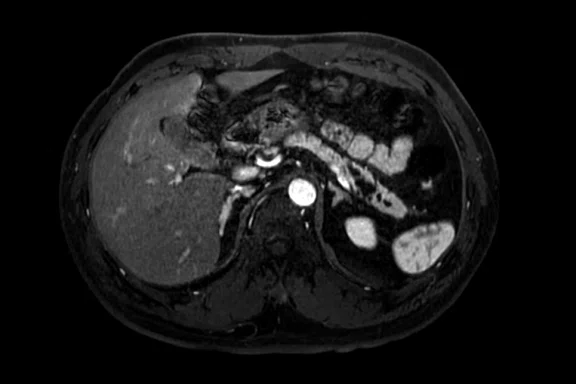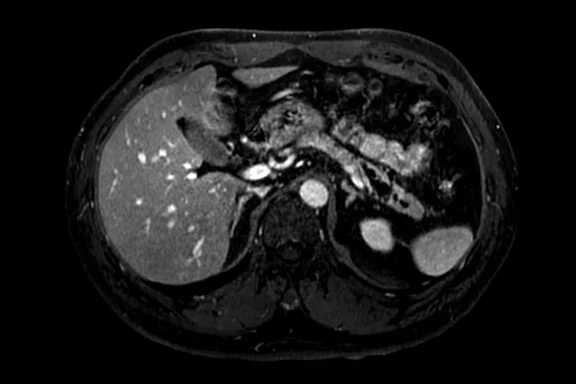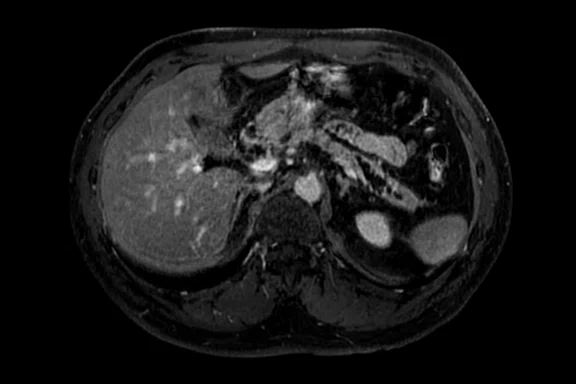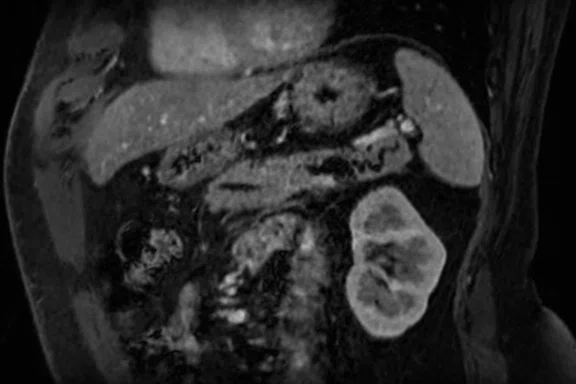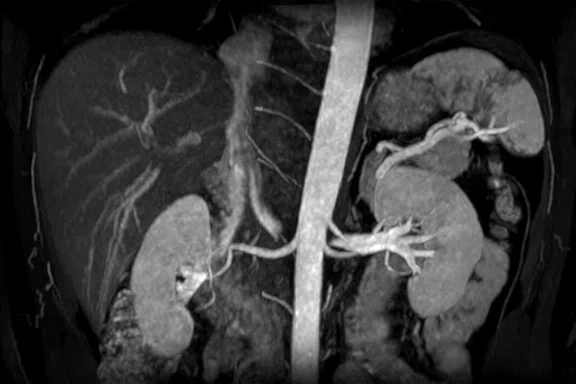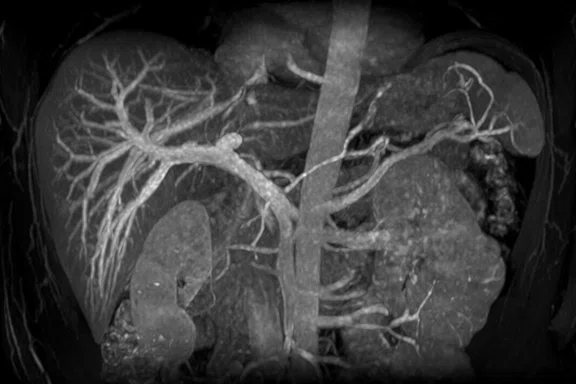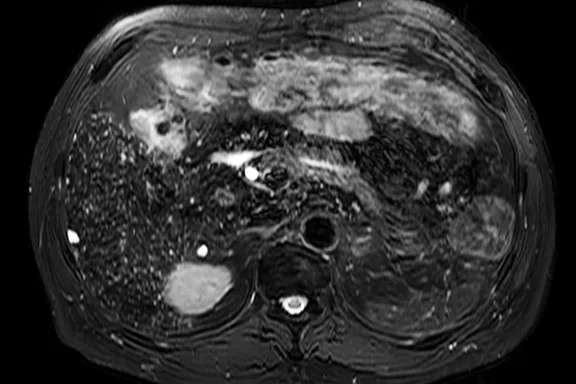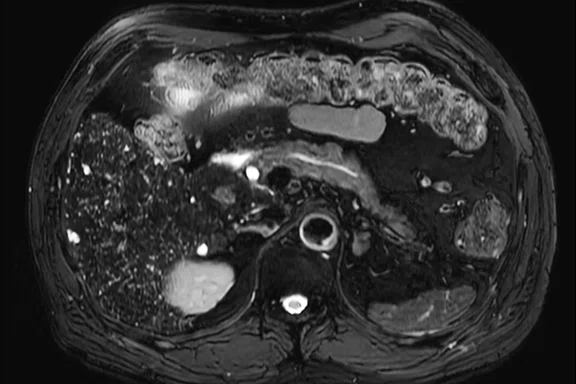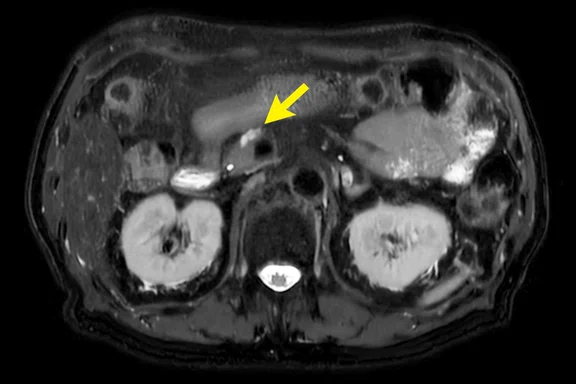result
A-1
Figure 1.
Comparison of T2w image in prostate exams, 0.4 x 0.7 x 3.0 mm, (A) with conventional reconstruction and (B) with AIR™ Recon DL.
A-2
Figure 1.
Comparison of T2w image in prostate exams, 0.4 x 0.7 x 3.0 mm, (A) with conventional reconstruction and (B) with AIR™ Recon DL.
B-1
Figure 1.
Comparison of T2w image in prostate exams, 0.4 x 0.7 x 3.0 mm, (A) with conventional reconstruction and (B) with AIR™ Recon DL.
B-2
Figure 1.
Comparison of T2w image in prostate exams, 0.4 x 0.7 x 3.0 mm, (A) with conventional reconstruction and (B) with AIR™ Recon DL.
A
Figure 2.
Dynamic LAVA with HyperSense in pancreas exam, 1.2 x 1.2 x 1.2 mm/0.6 sp. (A) dynamic 1st phase, (B) dynamic 2nd phase, (C) dynamic 3rd phase, (D) oblique coronal reformat, (E) MIP image in arterial phase, and (F) MIP image in portal-venous phase.
B
Figure 2.
Dynamic LAVA with HyperSense in pancreas exam, 1.2 x 1.2 x 1.2 mm/0.6 sp. (A) dynamic 1st phase, (B) dynamic 2nd phase, (C) dynamic 3rd phase, (D) oblique coronal reformat, (E) MIP image in arterial phase, and (F) MIP image in portal-venous phase.
C
Figure 2.
Dynamic LAVA with HyperSense in pancreas exam, 1.2 x 1.2 x 1.2 mm/0.6 sp. (A) dynamic 1st phase, (B) dynamic 2nd phase, (C) dynamic 3rd phase, (D) oblique coronal reformat, (E) MIP image in arterial phase, and (F) MIP image in portal-venous phase.
D
Figure 2.
Dynamic LAVA with HyperSense in pancreas exam, 1.2 x 1.2 x 1.2 mm/0.6 sp. (A) dynamic 1st phase, (B) dynamic 2nd phase, (C) dynamic 3rd phase, (D) oblique coronal reformat, (E) MIP image in arterial phase, and (F) MIP image in portal-venous phase.
E
Figure 2.
Dynamic LAVA with HyperSense in pancreas exam, 1.2 x 1.2 x 1.2 mm/0.6 sp. (A) dynamic 1st phase, (B) dynamic 2nd phase, (C) dynamic 3rd phase, (D) oblique coronal reformat, (E) MIP image in arterial phase, and (F) MIP image in portal-venous phase.
F
Figure 2.
Dynamic LAVA with HyperSense in pancreas exam, 1.2 x 1.2 x 1.2 mm/0.6 sp. (A) dynamic 1st phase, (B) dynamic 2nd phase, (C) dynamic 3rd phase, (D) oblique coronal reformat, (E) MIP image in arterial phase, and (F) MIP image in portal-venous phase.
A
Figure 3.
T2 SnapShot SSFSE provides more robust motion correction than T2 FSE. (A) T2 FSE and (B) T2 SnapShot SSFSE, both with AIR™ Recon DL and respiratory triggering.
B
Figure 3.
T2 SnapShot SSFSE provides more robust motion correction than T2 FSE. (A) T2 FSE and (B) T2 SnapShot SSFSE, both with AIR™ Recon DL and respiratory triggering.
A
Figure 4.
The combination of SnapShot SSFSE and AIR™ Recon DL enable more clear visualization of the IPMN (yellow arrow).


PREVIOUS
${prev-page}
NEXT
${next-page}
Subscribe Now
Manage Subscription
FOLLOW US
Contact Us • Cookie Preferences • Privacy Policy • California Privacy PolicyDo Not Sell or Share My Personal Information • Terms & Conditions • Security
© 2024 GE HealthCare. GE is a trademark of General Electric Company. Used under trademark license.
SPOTLIGHT
Leveling up image quality for confidence in cancer care
Leveling up image quality for confidence in cancer care
Osaka University Hospital, located in the north of Osaka prefecture, Japan, is one of the country’s premier facilities for advanced multidisciplinary treatment of cancer and malignant tumors. A large percentage of the hospital’s MR exams are performed to diagnose cancer and plan treatment. This need for detailed MR imaging inspired the facility to install SIGNA™Works AIR™ IQ Edition, including AIR™ Recon DL, in November 2020.
Osaka University Hospital, located in the north of Osaka prefecture, Japan, is one of the country’s premier facilities for advanced multidisciplinary treatment of cancer and malignant tumors. A large percentage of the hospital’s MR exams are performed to diagnose cancer and plan treatment. This need for detailed MR imaging inspired the facility to install SIGNA™Works AIR™ IQ Edition, including AIR™ Recon DL, in November 2020.
"As a university hospital, we have more complex cases requiring more detailed information for an accurate diagnosis. In routine examinations, we think the quality of the examination is important," says Hiromitsu Onishi, MD, PhD, Associate Professor at Osaka University Hospital.
Image reconstruction is at the heart of every MR scan, and reducing noise is critical to achieving high diagnostic quality images. AIR™ Recon DL is an innovative reconstruction technology from GE Healthcare based on deep learning that offers a fundamental shift in the balance between image quality and scan time. It results in TrueFidelity™ MR images that elevate the science of image reconstruction for clinical excellence without conventional compromises. It uses a neural network trained on tens of thousands of images to recognize patterns characteristic of noise and low resolution to reconstruct the ideal clinical image.
Improved SNR in abdominal imaging
Dr. Onishi reports the software upgrade is having a significant impact on the facility’s abdominal imaging, particularly in liver studies. The facility uses AIR™ Recon DL in liver and abdominal exams with Snapshot SSFSE imaging and T2 fast spin echo (FSE) imaging, for improved SNR.
"Since this version of SSFSE can use SnapShot SSFSE, the contrast of water (longer T2 tissue) is better than conventional SSFSE. In the case of cystic lesions of the pancreas like IPMN (Intraductal Papillary Mucinous Neoplasm), I think it’s useful because even small lesions are clearly delineated," says Dr. Onishi.
He adds that SnapShot SSFSE shortens the scan time compared to conventional SSFSE with respiratory triggering, as he is able to acquire multiple slices in each respiratory cycle. The entire liver can be covered in just a single acquisition, in under a one-minute scan time.
He notes that in abdominal T2-weighted imaging, FSE delivers better image quality in patients who can breathe steadily, but tends to degrade image quality in other patients. SnapShot SSFSE, however, is useful in these patients who have an unstable breathing cycle. In addition, SSFSE has a lower SNR than FSE and therefore can benefit from the increased SNR that can be achieved with AIR™ Recon DL. In liver imaging, the number of excitations (NEX) of FSE T2-weighted images was reduced from two to one, shortening the acquisition time.
At Osaka University, they combine SnapShot SSFSE with AIR™ Recon DL to improve exam time as well as better depict small cystic lesions such as intraductal papillary mucinous neoplasms, which are tumors that grow within the pancreatic ducts. "There’s no reason not to use AIR™ Recon DL for SnapShot SSFSE," Dr. Onishi adds. "In the pelvis, the combination of SnapShot SSFSE and AIR™ Recon DL is useful when a wide area needs to be scanned quickly."
Higher resolution scans
The facility is also using AIR™ Recon DL in prostate imaging, where T2-weighted images are an important sequence (Figure 1). Clinicians have updated their protocols because of the technology’s impact in reconstructing higher resolution and better SNR images. FSE T2-weighted images in prostate exams were changed to a higher spatial resolution by reducing the FOV and slice thickness.
Dr. Onishi says AIR™ Recon DL improves the depiction of anatomy and lesions, leading to higher diagnostic confidence.
"In the prostate, AIR™ Recon DL can increase the spatial resolution of the T2-weighted images, which makes it easier to see capsular invasion and cysts within nodules."
Dr. Hiromitsu Onishi
In addition, clinicians at Osaka University Hospital can more easily set up imaging protocols that comply with Prostate Imaging Reporting & Data System (PI-RADS®) guidelines.
"Until now, it was difficult to comply with PI-RADS® because SNR was too low. As a benefit of AIR™ Recon DL, the combination of improved image quality and reduced imaging time, by reducing the NEX and increasing the spatial resolution, is excellent. We are using LAVA Flex for T1-weighted imaging of the prostate, and we hope that AIR™ Recon DL can be applied to 3D sequences soon," says Dr. Onishi.
Improved abdominal sequences
As part of their software upgrade, the facility also implemented HyperSense from GE, an acceleration technique based on sparse data compressibility allowing scan time reduction while maintaining SNR efficiency. Osaka University Hospital uses HyperSense in nearly all of its pelvic MR studies to capture high-resolution images in less time. Currently, the hospital is performing dynamic imaging of the pelvis using DISCO with HyperSense.
"I think HyperSense can contribute to higher resolution for 3D LAVA in a reasonable time. I think it improves the quality of diagnosis. If it’s used to shorten the scan time, the motion artifact from bowel movement can be reduced."
Dr. Hiromitsu Onishi
HyperSense is used for exams that require detailed information, such as the pancreas and biliary system (Figure 2). For dynamic pancreas imaging, HyperSense helps to increase the spatial resolution and shorten the scanning time. Shortening the scanning time in the pancreas is useful because the organ is positionally susceptible to the movement of the stomach and intestinal tract.
Thin slice imaging is facilitated by HyperSense in the hepatobiliary phase of the liver as well as in the prostate, uterus and rectum scans.
The hospital is using HyperSense to acquire thinner slice images. "We’re scanning with thin slice thickness in body MR imaging thanks to HyperSense, which can be observed with reformatting. I think that reformatted MR images from thin slice imaging can be used clinically," says Dr. Onishi.
The facility also implemented the new non-Cartesian, accelerated acquisition DISCO Star sequence. "I think that DISCO Star should be used in patients who need a liver EOB study and cannot hold their breath," says Dr. Onishi
Clinicians at Osaka University Hospital have embraced the use of deep-learning reconstruction in both MR and CT imaging. Although the noise reduction in CT imaging is impressive, Dr. Onishi feels MR imaging will benefit more because MR images have better contrast resolution than CT images. Plus, the added benefit of MR scan time reductions with AIR™ Recon DL may increase the utilization of MR in cases where the better contrast resolution aids patient evaluation and diagnosis.
"If in the future, AIR™ Recon DL and other advancements in MR can achieve sub-millimeter slice thickness within a breath-hold like CT, then we may see a change in how MR is used for patient diagnosis," Dr. Onishi adds.











